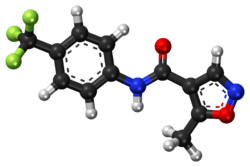Chemistry:Leflunomide
 | |
 | |
| Clinical data | |
|---|---|
| Trade names | Arava, Lefumide, Arabloc, others |
| AHFS/Drugs.com | Monograph |
| MedlinePlus | a600032 |
| License data |
|
| Pregnancy category |
|
| Routes of administration | By mouth |
| ATC code | |
| Legal status | |
| Legal status | |
| Pharmacokinetic data | |
| Bioavailability | 80%[5] |
| Protein binding | >99%[5] |
| Metabolism | GI mucosa and liver[5] |
| Metabolites | Teriflunomide |
| Elimination half-life | 14–18 days[5] |
| Excretion | Faeces (48%), urine (43%)[5] |
| Identifiers | |
| |
| CAS Number | |
| PubChem CID | |
| IUPHAR/BPS | |
| DrugBank | |
| ChemSpider | |
| UNII | |
| KEGG | |
| ChEBI | |
| ChEMBL | |
| Chemical and physical data | |
| Formula | C12H9F3N2O2 |
| Molar mass | 270.211 g·mol−1 |
| 3D model (JSmol) | |
| |
| |
| (verify) | |
Leflunomide, sold under the brand name Arava among others, is an immunosuppressive disease-modifying antirheumatic drug (DMARD),[6] used in active moderate-to-severe rheumatoid arthritis and psoriatic arthritis. It is a pyrimidine synthesis inhibitor that works by inhibiting dihydroorotate dehydrogenase.[7]
Medical use
Rheumatoid arthritis and psoriatic arthritis are the only indications that have received regulatory approval.[5][8] Arava was developed by Sanofi Aventis and approved by the U.S. Food and Drug Administration in 1998. Clinical studies regarding the following diseases have been conducted:[9] There has been reports on potential re-purposing of leflunomide for treatment of solid tumors with tumor suppressor, PTEN, loss.[10][11] In PTEN negative tumors, leflunomide causes synthetic lethality potentially due to increased demand on pyrimidines in these faster growing cells.[11]
- Polyoma BK virus nephropathy[12]
- Kimura's disease[13]
- Systemic lupus erythematosus[14]
- Felty's syndrome[15]
- Takayasu arteritis[16]
- Granulomatosis with polyangiitis[15]
- Ankylosing spondylitis[17]
- Crohn's disease[18][19]
- Sarcoidosis[20]
- Uveitis[21]
- Still's disease[22]
- Prostate cancer[23]
- Pemphigoid[24]
- Prevention of organ transplant rejection[25]
Side effects
The dose-limiting side effects are liver damage, lung disease and immunosuppression.[25] The most common side effects (occurring in >1% of those treated with it) are, in approximately descending order of frequency:[5][8][1][26][27][3][2] diarrhea, respiratory tract infections, hair loss, high blood pressure, rash, nausea, bronchitis, headache, abdominal pain, abnormal liver function tests, back pain, indigestion, urinary tract infection, dizziness, infection, joint disorder, itchiness, weight loss, loss of appetite, cough, gastroenteritis, pharyngitis, stomatitis, tenosynovitis, vomiting, weakness, allergic reaction, chest pain, dry skin, eczema, paraesthesia, pneumonia, rhinitis, synovitis, cholelithiasis and shortness of breath. Whereas uncommon side effects (occurring in 0.1-1% of those treated with the drug) include:[8] constipation, oral thrush, stomatitis, taste disturbance, thrombocytopenia and hives. Rarely (in 0.1% of those treated with it) it can cause:[8] anaphylaxis, angiooedema, anaemia, agranulocytosis, eosinophilia, leucopenia, pancytopenia, vasculitis, toxic epidermal necrolysis, Stevens–Johnson syndrome, cutaneous lupus erythematosus, severe infection, interstitial lung disease, cirrhosis and liver failure.
Contraindications
Contraindications include:[5]
- Pregnancy, women of childbearing potential (unless contraception used)
- Liver disease, hepatitis B/C seropositive
- Active serious infections
- Hypersensitivity
Interactions
Other immunomodulatory treatments should be avoided due to the potential for additive immunosuppressant effects, or in the case of immunostimulants like echinacea or astragalus, reduced therapeutic effects.[5] Likewise live vaccines (like haemophilus influenzae type b vaccine and yellow fever vaccines) should be avoided due to the potential for severe infection due to the immunosuppressive nature of the treatment.[5]
The concomitant use of methotrexate, in particular, may lead to severe or even fatal liver-damage or hepatotoxicity. Seventy-five percent of all cases of severe liver damage reported until early 2001 were seen under combined drug therapy leflunomide plus methotrexate.[28] However, some studies have shown that the combination of methotrexate and leflunomide in patients with rheumatoid arthritis gave better results than either drug alone.[28]
Mechanism of action
Leflunomide is an immunomodulatory drug that achieves its effects by inhibiting the mitochondrial enzyme dihydroorotate dehydrogenase (DHODH), which plays a key role in the de novo synthesis of uridine monophosphate (rUMP), which is required for the synthesis of DNA and RNA. Hence, leflunomide inhibits the reproduction of rapidly dividing cells, especially lymphocytes.[25]
The inhibition of human DHODH by teriflunomide, the active metabolite of leflunomide, occurs at levels (approximately 600 nM) that are achieved during treatment of rheumatoid arthritis (RA).[29] Teriflunomide also inhibits several tyrosine kinases.[25] Teriflunomide prevents the expansion of activated and autoimmune lymphocytes by interfering with their cell cycle progression while nonlymphoid cells are able to use another pathway to make their ribonucleotides by use of salvage pyrimidine pathway, which makes them less dependent on de novo synthesis.[29] Teriflunomide also has antiviral effects against numerous viruses including CMV, HSV1 and the BK virus, which it achieves by inhibiting viral replication by interfering with nucleocapsid tegumentation and hence virion assembly.[25]
Pharmacokinetics
It has an oral bioavailability of 80%, protein binding of >99%, metabolism sites of the GI mucosa and liver, volume of distribution (Vd) of 0.13 L/kg, elimination half-life of 14–18 days and excretion routes of faeces (48%) and urine (43%).[5][25][1]
Leflunomide metabolism
Teriflunomide is the main active in vivo metabolite of leflunomide. Upon administration of leflunomide, 70% of the drug administered converts into teriflunomide. The only difference between the molecules is the opening of the isoxazole ring. Upon oral administration of leflunomide in vivo, the isoxazole ring of leflunomide is opened and teriflunomide is formed.[30]

"Regardless of the substance administered (leflunomide or teriflunomide), it is the same molecule (teriflunomide)—the one exerting the pharmacological, immunological or metabolic action in view of restoring, correcting or modifying physiological functions, and does not present, in clinical use, a new chemical entity to patients."[30] Because of this, the European Medicines Agency (EMA) initially had not considered teriflunomide to be a new active substance.[33]
References
- ↑ 1.0 1.1 1.2 "Arava Product Information" (PDF). TGA eBusiness Services. sanofi-aventis australia pty ltd. 7 August 2012. https://www.ebs.tga.gov.au/ebs/picmi/picmirepository.nsf/pdf?OpenAgent&id=CP-2010-PI-05926-3.
- ↑ 2.0 2.1 "Arava 10mg Tablets - Summary of Product Characteristic". electronic Medicines Compendium. Sanofi. 21 February 2014. https://www.medicines.org.uk/emc/product/4056/smpc.
- ↑ 3.0 3.1 "Arava (leflunomide) tablet, film coated [sanofi-aventis U.S. LLC"]. DailyMed. sanofi-aventis U.S. LLC. November 2012. http://dailymed.nlm.nih.gov/dailymed/lookup.cfm?setid=320f63f2-fac3-4aee-aff8-85724e00ef52.
- ↑ "Arava EPAR". 25 August 2023. https://www.ema.europa.eu/en/medicines/human/EPAR/arava.
- ↑ 5.00 5.01 5.02 5.03 5.04 5.05 5.06 5.07 5.08 5.09 5.10 "Arava (leflunomide) dosing, indications, interactions, adverse effects, and more". Medscape Reference. WebMD. http://reference.medscape.com/drug/arava-leflunomide-343203#showall.
- ↑ "When a DMARD fails, should patients switch to sulfasalazine or add sulfasalazine to continuing leflunomide?". Annals of the Rheumatic Diseases 64 (1): 44–51. January 2005. doi:10.1136/ard.2003.016709. PMID 15271770.
- ↑ "Leflunomide in clinical practice". Acta Reumatologica Portuguesa 31 (3): 215–24. 2006. PMID 17094333. http://www.actareumatologica.pt/oldsite/conteudo/pdfs/ARP_2006_4_216_AR_-_Leflunomide.pdf.
- ↑ 8.0 8.1 8.2 8.3 Australian Medicines Handbook. Adelaide: The Australian Medicines Handbook Unit Trust. 2013. ISBN 978-0-9805790-9-3.[page needed]
- ↑ "Leflunomide Search". ClinicalTrials.gov. U.S. National Library of Medicine. http://clinicaltrials.gov/ct2/results?term=Leflunomide.
- ↑ "Leflunomide triggers synthetic lethality in PTEN-deficient prostate cancer". Prostate Cancer and Prostatic Diseases 23 (4): 718–723. December 2020. doi:10.1038/s41391-020-0251-1. PMID 32661432.
- ↑ 11.0 11.1 "PTEN Regulates Glutamine Flux to Pyrimidine Synthesis and Sensitivity to Dihydroorotate Dehydrogenase Inhibition". Cancer Discovery 7 (4): 380–390. April 2017. doi:10.1158/2159-8290.CD-16-0612. PMID 28255082.
- ↑ "Current recommendations for diagnosis and management of polyoma BK virus nephropathy in renal transplant recipients". Nephrology, Dialysis, Transplantation 21 (12): 3364–7. December 2006. doi:10.1093/ndt/gfl404. PMID 16998219.
- ↑ "Effective treatment of Kimura's disease with leflunomide in combination with glucocorticoids". Clinical Rheumatology 30 (6): 859–65. June 2011. doi:10.1007/s10067-011-1689-2. PMID 21286771.
- ↑ "Leflunomide: friend or foe for systemic lupus erythematosus?". Rheumatology International 33 (2): 273–6. February 2013. doi:10.1007/s00296-012-2508-z. PMID 22961090.
- ↑ 15.0 15.1 "Leflunomide for the treatment of rheumatoid arthritis and autoimmunity". The American Journal of the Medical Sciences 323 (4): 190–3. April 2002. doi:10.1097/00000441-200204000-00004. PMID 12003373.
- ↑ "New treatment strategies in large-vessel vasculitis". Current Opinion in Rheumatology 25 (1): 3–9. January 2013. doi:10.1097/BOR.0b013e32835b133a. PMID 23114585.
- ↑ "Six months open label trial of leflunomide in active ankylosing spondylitis". Annals of the Rheumatic Diseases 64 (1): 124–6. January 2005. doi:10.1136/ard.2003.019174. PMID 15608310.
- ↑ "Leflunomide treatment of Crohn's disease patients intolerant to standard immunomodulator therapy". Journal of Clinical Gastroenterology 37 (2): 125–8. August 2003. doi:10.1097/00004836-200308000-00006. PMID 12869881.
- ↑ "Treatment of Crohn's disease with leflunomide as second-line immunosuppression : a phase 1 open-label trial on efficacy, tolerability and safety". Digestive Diseases and Sciences 53 (4): 1025–32. April 2008. doi:10.1007/s10620-007-9953-7. PMID 17934840.
- ↑ "Acute pulmonary exacerbations of sarcoidosis". Chest 142 (4): 827–836. October 2012. doi:10.1378/chest.12-1060. PMID 23032450.
- ↑ "Early clinical experience with leflunomide in uveitis". Canadian Journal of Ophthalmology 42 (4): 634. August 2007. doi:10.3129/can.j.ophthalmol.i07-085. PMID 17641721.
- ↑ "Treatment of adult-onset Still's disease with leflunomide and chloroquine combination in two patients". Clinical Rheumatology 22 (2): 157. May 2003. doi:10.1007/s10067-002-0667-0. PMID 12740686.
- ↑ Clinical trial number NCT00004071 for "Mitoxantrone and Prednisone With or Without Leflunomide in Treating Patients With Stage IV Prostate Cancer" at ClinicalTrials.gov
- ↑ Clinical trial number NCT00802243 for "Leflunomide Associated With Topical Corticosteroids for Bullous Pemphigoid (ARABUL)" at ClinicalTrials.gov
- ↑ 25.0 25.1 25.2 25.3 25.4 25.5 "Leflunomide: a drug with a potential beyond rheumatology". Immunotherapy 2 (5): 637–50. September 2010. doi:10.2217/imt.10.52. PMID 20874647.
- ↑ "Arava : EPAR - Product Information". European Medicines Agency. Sanofi-Aventis Deutschland GmbH. 21 November 2013. http://www.ema.europa.eu/docs/en_GB/document_library/EPAR_-_Product_Information/human/000235/WC500026289.pdf.
- ↑ "Data Sheet Arava". Medsafe. sanofi-aventis new zealand limited. 29 June 2012. http://www.medsafe.govt.nz/profs/datasheet/a/aravatab.pdf.
- ↑ 28.0 28.1 "Combination treatment with leflunomide and methotrexate for patients with active rheumatoid arthritis". Scandinavian Journal of Rheumatology 38 (1): 11–4. 2009. doi:10.1080/03009740802360632. PMID 19191187.
- ↑ 29.0 29.1 "Mechanism of action for leflunomide in rheumatoid arthritis". Clinical Immunology 93 (3): 198–208. December 1999. doi:10.1006/clim.1999.4777. PMID 10600330.
- ↑ 30.0 30.1 "Assessment report. AUBAGIO (international non-proprietary name: teriflunomide). Procedure No. EMEA/H/C/002514/0000". p. 119. http://www.ema.europa.eu/docs/en_GB/document_library/EPAR_-_Public_assessment_report/human/002514/WC500148684.pdf.
- ↑ "Clinical pharmacokinetics of leflunomide". Clinical Pharmacokinetics 41 (6): 421–30. 2002. doi:10.2165/00003088-200241060-00003. PMID 12074690.
- ↑ "Clinical Pharmacology/Biopharmaceutics Review. Product: ARAVA (leflunomide tablets). Application Number: NDA 20905". Center for Drug Evaluation and Research. http://www.accessdata.fda.gov/drugsatfda_docs/nda/98/20905_ARAVA_BIOPHARMR.PDF.
- ↑ "Summary of Opinion (Initial Authorisation): Aubagio (teriflunomide)". European Medicines Agency. http://www.ema.europa.eu/docs/en_GB/document_library/Summary_of_opinion_-_Initial_authorisation/human/002514/WC500144913.pdf.
Further reading
- "The safety of leflunomide". Australian Prescriber 36 (1): 28–32. February 2013. doi:10.18773/austprescr.2013.010.
 |


